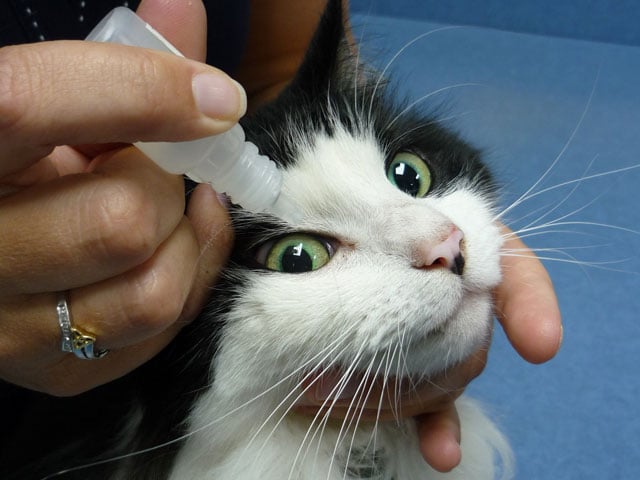Why Do Cats Have Eye Discharge? Causes and Treatment Methods
Eye discharge in cats is one of the most common health issues pet owners encounter. While it can be normal, it may also indicate a serious health problem. In this comprehensive guide, you'll learn about the causes, types, treatment methods of cat eye discharge, and when you should visit a veterinarian.
👁️ What Is Eye Discharge and Why Does It Occur?
Basic causes of eye discharge:
- Normal Cleaning: Eyes naturally produce discharge for self-cleaning
- Infections: Bacterial or viral infections
- Allergies: Environmental or food allergies
- Foreign Object: Dust, dirt, or hair in the eye
- Eye Injuries: Scratching or impact
- Eye Structure: Anatomical features of breeds like Persian
🎨 Types of Eye Discharge and Their Meanings
Clear/Watery Discharge
Least concerning type:
- Causes: Allergies, mild irritation, tear duct blockage
- Appearance: Water-like, clear, odorless
- Status: Usually mild, requires monitoring
- Action: Clean eye with clean water, monitor for 2-3 days
White/Cream Colored Discharge
Mucoid discharge:
- Causes: Dry eye syndrome, tear duct blockage
- Appearance: Thick, sticky, whitish
- Status: Veterinary check recommended
- Action: Eye drops may be needed
Yellow/Green Discharge
Most serious type:
- Causes: Bacterial infection, serious eye disease
- Appearance: Dark yellow or greenish, foul-smelling
- Status: Emergency veterinary intervention required
- Action: Take to vet immediately, antibiotics may be needed
Bloody Discharge
Emergency situation:
- Causes: Eye injury, serious infection, trauma
- Appearance: Reddish or brownish
- Status: Emergency veterinary intervention mandatory
- Action: Take to vet immediately
🦠 Common Causes and Diseases
1. Cat Flu (Upper Respiratory Infection)
Most common cause:
- Symptoms: Eye discharge, sneezing, nasal discharge, fever
- Causes: Herpesvirus, Calicivirus
- Treatment: Antivirals, antibiotics, supportive care
- Duration: 1-3 weeks
- Prevention: Regular vaccination
2. Conjunctivitis (Eye Inflammation)
Inflammation of eye membrane:
- Symptoms: Red eye, swelling, discharge, itching
- Causes: Bacterial, viral, or allergic
- Treatment: Eye ointment, antibiotic drops
- Duration: 1-2 weeks
- Contagious: Infectious types are contagious
3. Keratoconjunctivitis (Dry Eye)
Tear deficiency:
- Symptoms: Thick mucus discharge, dull eye, redness
- Causes: Reduced tear production
- Treatment: Tear stimulant drops, lifelong treatment
- Risk: Blindness if untreated
4. Corneal Ulcer
Cornea injury:
- Symptoms: Severe pain, keeping eye closed, discharge
- Causes: Scratching, foreign object, infection
- Treatment: Antibiotic ointment, pain relief
- Urgency: Fast treatment required
- Recovery: 1-3 weeks
5. Tear Duct Blockage
Tear drainage problem:
- Symptoms: Constant tearing, brown staining
- Causes: Congenital narrow duct, infection
- Treatment: Duct opening, antibiotics
- Risk Breeds: Persian, Himalayan, Exotic Shorthair
🏠 Home Care and First Aid
What you can do before visiting the vet:
- Cleaning: Clean around eyes with wet cotton
- Saline Solution: Wash with isotonic saline
- Warm Compress: Wipe with slightly warm cotton
- Isolation: Separate from other cats
- Monitoring: Track symptom changes
- Prevent Scratching: Use Elizabeth collar
⚠️ When to Visit the Vet?
Situations requiring urgent veterinary visit:
- 🚨 Yellow or green pus discharge
- 🚨 Bloody discharge
- 🚨 Eye swollen or protruding
- 🚨 Eye cloudy or whitish
- 🚨 Cat keeps eye constantly closed
- 🚨 Discharge lasting more than 3 days
- 🚨 Problem in both eyes simultaneously
- 🚨 Loss of appetite, lethargy accompanying
💊 Treatment Methods
Veterinary Treatments
- Antibiotic Eye Ointment: For bacterial infections
- Antiviral Medications: For viral infections
- Tear Stimulants: For dry eye
- Antihistamines: For allergic conditions
- Pain Relief: In severe cases
- Surgery: Duct opening, foreign object removal
Natural Support Methods
- Chamomile Tea: Clean with cooled, diluted chamomile tea
- Lysine Supplement: For immune support
- Omega-3: Reduces inflammation
- Probiotics: Supports general health
- Vitamin E: For eye health
🛡️ Preventive Measures
To prevent eye discharge:
- Regular Vaccination: Protection against cat flu
- Cleaning: Weekly eye area cleaning
- Stress Reduction: Stress triggers viral diseases
- Indoor Environment: Protect from outdoor hazards
- Quality Nutrition: Immune system support
- Regular Checkups: 1-2 vet visits per year
🏥 Breed-Based Risk Factors
High-risk breeds:
- Persian: Tear duct blockage, chronic discharge
- Himalayan: Similar issues to Persian
- Exotic Shorthair: Due to flat face structure
- British Shorthair: Large eye structure
- Scottish Fold: Prone to eye infections
📋 Post-Treatment Care
Things to consider during recovery:
- Medication Schedule: Continue for vet-recommended duration
- Cleaning: 2-3 times daily eye cleaning
- Monitoring: Keep daily recovery records
- Prevent Scratching: Use protective collar if needed
- Follow-up Appointment: Vet-determined checkup
- Other Cats: Isolate until fully recovered
💡 Common Mistakes
Situations to avoid:
- ❌ Using human eye drops
- ❌ Using old medications
- ❌ Antibiotics without vet recommendation
- ❌ Stopping treatment early
- ❌ Using dirty cotton or cloth
- ❌ Blindly trusting internet advice
If you don't have a cat yet and want to adopt a healthy cat, you can check out healthy, vet-checked cats on our Petopic.com cat adoption page.
Remember, eye discharge is usually a treatable condition. With early intervention and proper treatment, your cat can quickly return to its healthy state. In case of doubt, always seek veterinary support and regularly check your cat's eye health!
